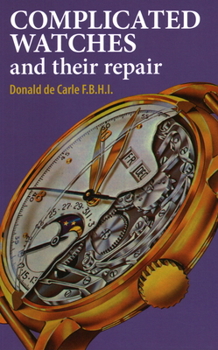Complicated Watches and Their Repair
Dealing with a complicated watch used to be a rare job for the watch repairer, but with the popularity of the automatic, it is almost commonplace. Furthermore, the increased interest in calendar work, alarm watches, and chronographs will undoubtedly bring more and more complicated work into the workshop. This book deals with complicated work essentially from the repairer's point of view. The action of each mechanism is briefly and clearly described because understanding this is essential to proper servicing, repair and testing for functioning. Dismantling and assembly instructions are given, as well as oiling charts and - most important - hints on fault-finding and their rectification. Another essential feature of the book is that it deals with all complicated work - from the relatively simple automatic to the triple-complicated watch with chronograph, calendar and repeater work, and the very complicated clock watch. Exceptional care has been taken in the preparation of diagrams, which have been drawn from actual movements in various stages of assembly, so that the reader can actually work with the book illustrations beside the watch itself. As always with books by Donald de Carle, instructions are easy to follow and there is no reason why anyone well versed in ordinary work and able to use watchmakers' tools should not become a specialist in complicated watches and their repair.
Format:Hardcover
Language:English
ISBN:0719800900
ISBN13:9780719800900
Release Date:July 1995
Publisher:Robert Hale & Company
Length:184 Pages
Weight:1.00 lbs.
Dimensions:1.0" x 5.5" x 8.6"
Customer Reviews
2 ratings
Great horological book
Published by Thriftbooks.com User , 16 years ago
This book cover the maintence of several automatic movements, chronographs, split seconds and repeaters. Unfortunately it dont't cover the tourbillon. Whereas the book was written in 1956, there are no mention for the Valjoux 7750 movement series nor the new complicated movements such as the IWC Da Vinci caliber with perpetual calendar.
A complement to Practical Watch Repairing
Published by Thriftbooks.com User , 17 years ago
I don't agree with the last review. This book has to be viewed as a complement, a second volume, to Practical Watch Repairing of the same author. You have to read the first book to fully understand it. If you look at this book as a second volume of the classic Practical Watch Repairing, it deserves 4 stars. It does not cover new automatic movements from the 70s and 80s, but every automatic system used by the industry is documented. Well, if you can repair an ETA or Omega from the 50s or 60s, you can repair a movement from the 80s and 90s. That's my point of view.







